Open Economy Macroeconomics: Analyzing the UK Economy Post-Brexit
VerifiedAdded on 2021/04/24
|12
|1977
|148
Report
AI Summary
This report provides a comprehensive analysis of the UK economy in the context of open economy macroeconomics, with a specific focus on the impact of Brexit. It begins by assessing the current state of the UK economy, examining key indicators such as GDP growth, household savings, standard of living, unemployment rates, and the value of the pound. The report then delves into an open economy model, illustrating the effects of Brexit through shifts in the AD, ERU, and BT curves. It explores both short-run and long-run implications, including the impact on aggregate demand, trade, and exchange rates. Furthermore, the report discusses potential policy responses, including monetary and fiscal stimulus, and analyzes the effects of Brexit on specific sectors such as banking and automobile industries. The analysis incorporates relevant economic models and data to provide a thorough understanding of Brexit's multifaceted economic consequences. This document is contributed by a student to be published on the website Desklib. Desklib is a platform which provides all the necessary AI based study tools for students.
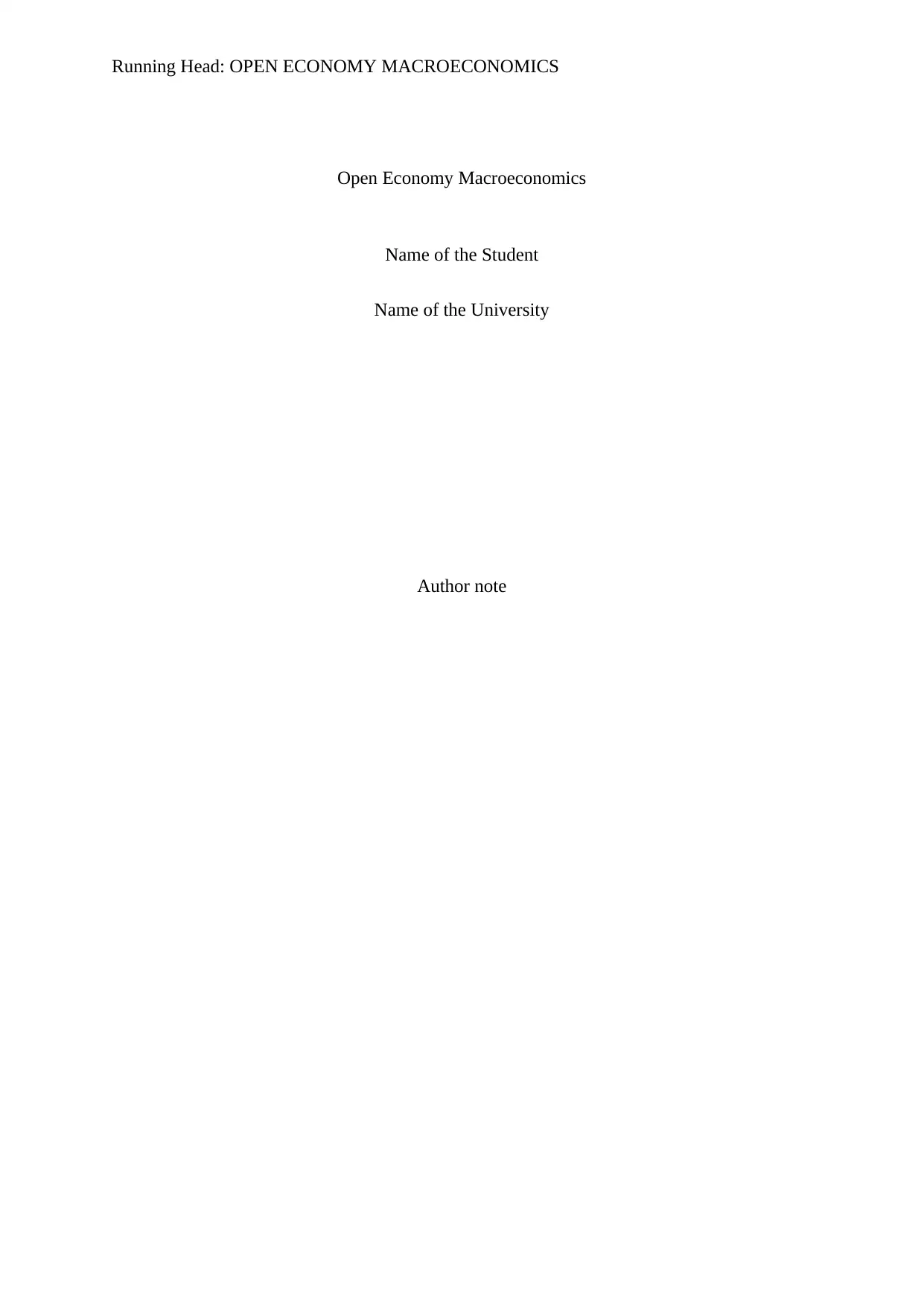
Running Head: OPEN ECONOMY MACROECONOMICS
Open Economy Macroeconomics
Name of the Student
Name of the University
Author note
Open Economy Macroeconomics
Name of the Student
Name of the University
Author note
Paraphrase This Document
Need a fresh take? Get an instant paraphrase of this document with our AI Paraphraser
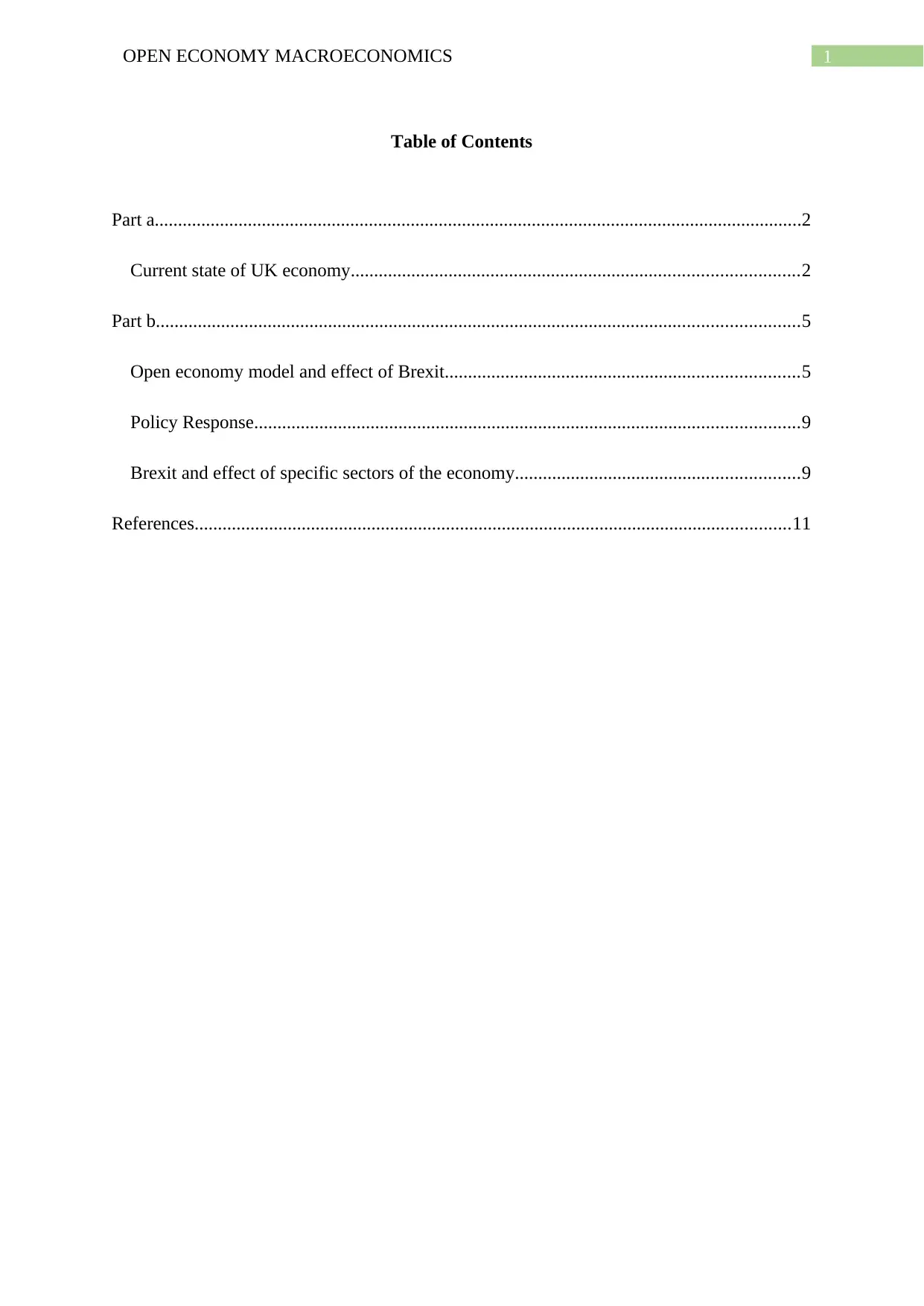
1OPEN ECONOMY MACROECONOMICS
Table of Contents
Part a...........................................................................................................................................2
Current state of UK economy................................................................................................2
Part b..........................................................................................................................................5
Open economy model and effect of Brexit............................................................................5
Policy Response.....................................................................................................................9
Brexit and effect of specific sectors of the economy.............................................................9
References................................................................................................................................11
Table of Contents
Part a...........................................................................................................................................2
Current state of UK economy................................................................................................2
Part b..........................................................................................................................................5
Open economy model and effect of Brexit............................................................................5
Policy Response.....................................................................................................................9
Brexit and effect of specific sectors of the economy.............................................................9
References................................................................................................................................11
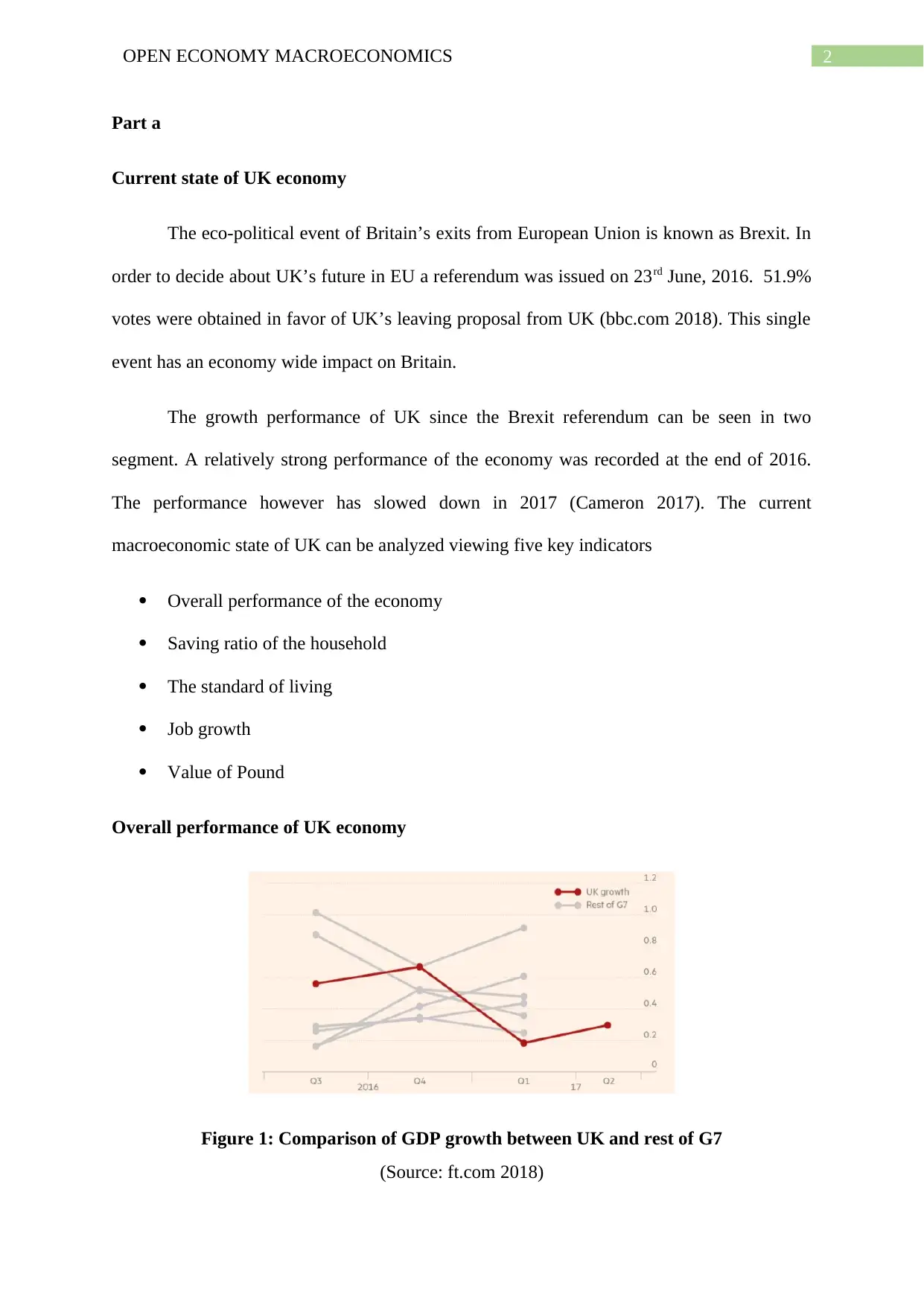
2OPEN ECONOMY MACROECONOMICS
Part a
Current state of UK economy
The eco-political event of Britain’s exits from European Union is known as Brexit. In
order to decide about UK’s future in EU a referendum was issued on 23rd June, 2016. 51.9%
votes were obtained in favor of UK’s leaving proposal from UK (bbc.com 2018). This single
event has an economy wide impact on Britain.
The growth performance of UK since the Brexit referendum can be seen in two
segment. A relatively strong performance of the economy was recorded at the end of 2016.
The performance however has slowed down in 2017 (Cameron 2017). The current
macroeconomic state of UK can be analyzed viewing five key indicators
Overall performance of the economy
Saving ratio of the household
The standard of living
Job growth
Value of Pound
Overall performance of UK economy
Figure 1: Comparison of GDP growth between UK and rest of G7
(Source: ft.com 2018)
Part a
Current state of UK economy
The eco-political event of Britain’s exits from European Union is known as Brexit. In
order to decide about UK’s future in EU a referendum was issued on 23rd June, 2016. 51.9%
votes were obtained in favor of UK’s leaving proposal from UK (bbc.com 2018). This single
event has an economy wide impact on Britain.
The growth performance of UK since the Brexit referendum can be seen in two
segment. A relatively strong performance of the economy was recorded at the end of 2016.
The performance however has slowed down in 2017 (Cameron 2017). The current
macroeconomic state of UK can be analyzed viewing five key indicators
Overall performance of the economy
Saving ratio of the household
The standard of living
Job growth
Value of Pound
Overall performance of UK economy
Figure 1: Comparison of GDP growth between UK and rest of G7
(Source: ft.com 2018)
⊘ This is a preview!⊘
Do you want full access?
Subscribe today to unlock all pages.

Trusted by 1+ million students worldwide
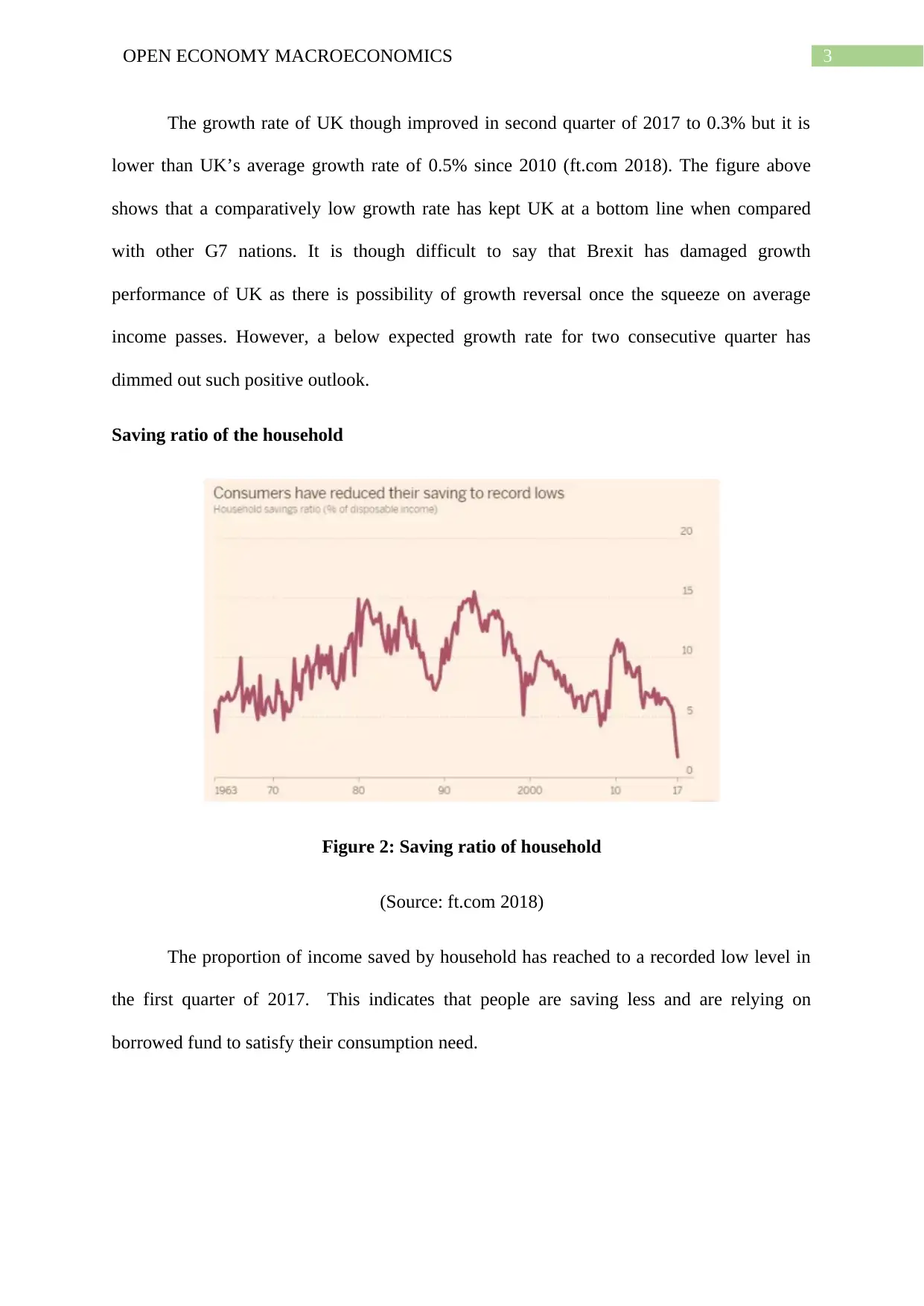
3OPEN ECONOMY MACROECONOMICS
The growth rate of UK though improved in second quarter of 2017 to 0.3% but it is
lower than UK’s average growth rate of 0.5% since 2010 (ft.com 2018). The figure above
shows that a comparatively low growth rate has kept UK at a bottom line when compared
with other G7 nations. It is though difficult to say that Brexit has damaged growth
performance of UK as there is possibility of growth reversal once the squeeze on average
income passes. However, a below expected growth rate for two consecutive quarter has
dimmed out such positive outlook.
Saving ratio of the household
Figure 2: Saving ratio of household
(Source: ft.com 2018)
The proportion of income saved by household has reached to a recorded low level in
the first quarter of 2017. This indicates that people are saving less and are relying on
borrowed fund to satisfy their consumption need.
The growth rate of UK though improved in second quarter of 2017 to 0.3% but it is
lower than UK’s average growth rate of 0.5% since 2010 (ft.com 2018). The figure above
shows that a comparatively low growth rate has kept UK at a bottom line when compared
with other G7 nations. It is though difficult to say that Brexit has damaged growth
performance of UK as there is possibility of growth reversal once the squeeze on average
income passes. However, a below expected growth rate for two consecutive quarter has
dimmed out such positive outlook.
Saving ratio of the household
Figure 2: Saving ratio of household
(Source: ft.com 2018)
The proportion of income saved by household has reached to a recorded low level in
the first quarter of 2017. This indicates that people are saving less and are relying on
borrowed fund to satisfy their consumption need.
Paraphrase This Document
Need a fresh take? Get an instant paraphrase of this document with our AI Paraphraser
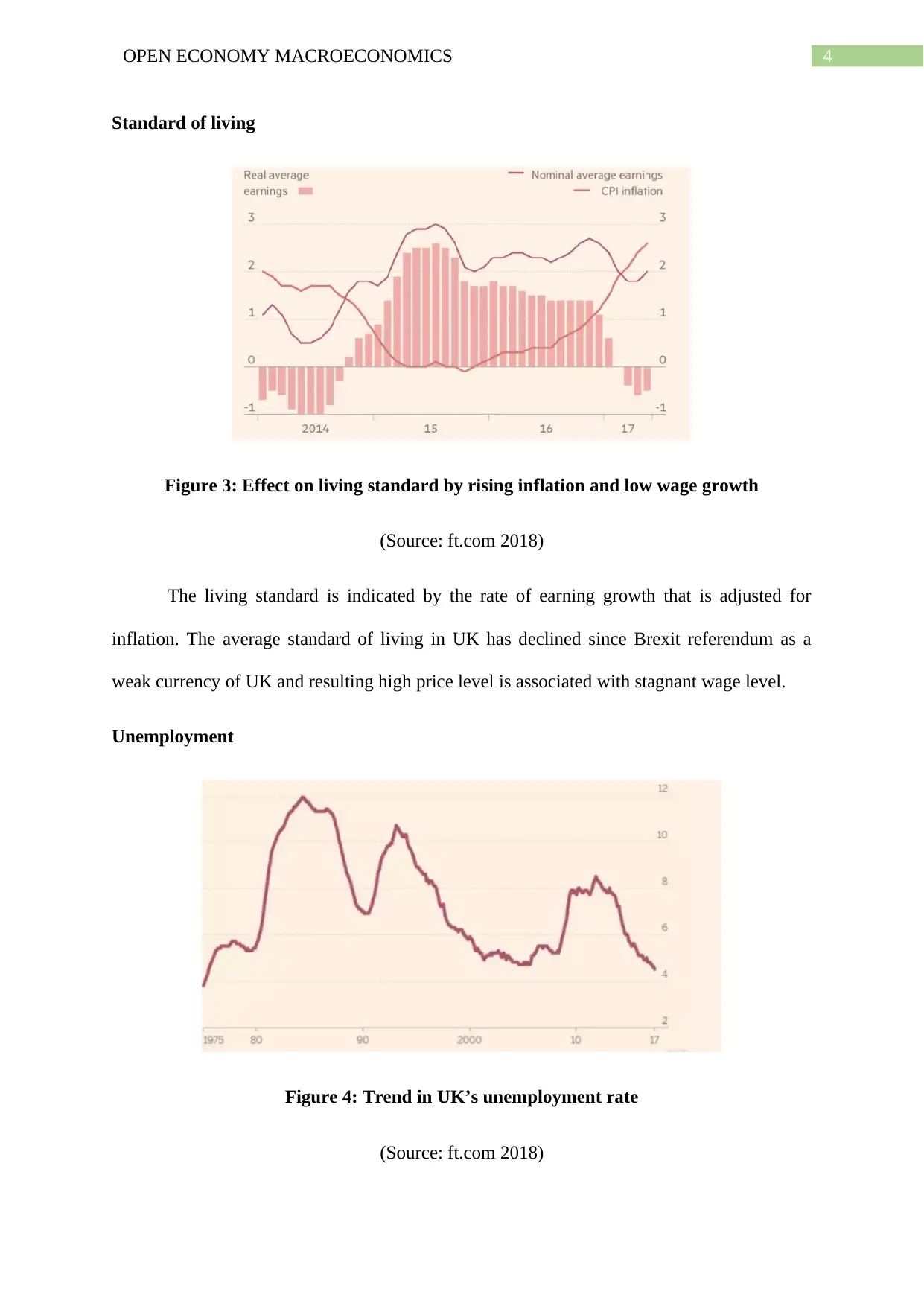
4OPEN ECONOMY MACROECONOMICS
Standard of living
Figure 3: Effect on living standard by rising inflation and low wage growth
(Source: ft.com 2018)
The living standard is indicated by the rate of earning growth that is adjusted for
inflation. The average standard of living in UK has declined since Brexit referendum as a
weak currency of UK and resulting high price level is associated with stagnant wage level.
Unemployment
Figure 4: Trend in UK’s unemployment rate
(Source: ft.com 2018)
Standard of living
Figure 3: Effect on living standard by rising inflation and low wage growth
(Source: ft.com 2018)
The living standard is indicated by the rate of earning growth that is adjusted for
inflation. The average standard of living in UK has declined since Brexit referendum as a
weak currency of UK and resulting high price level is associated with stagnant wage level.
Unemployment
Figure 4: Trend in UK’s unemployment rate
(Source: ft.com 2018)
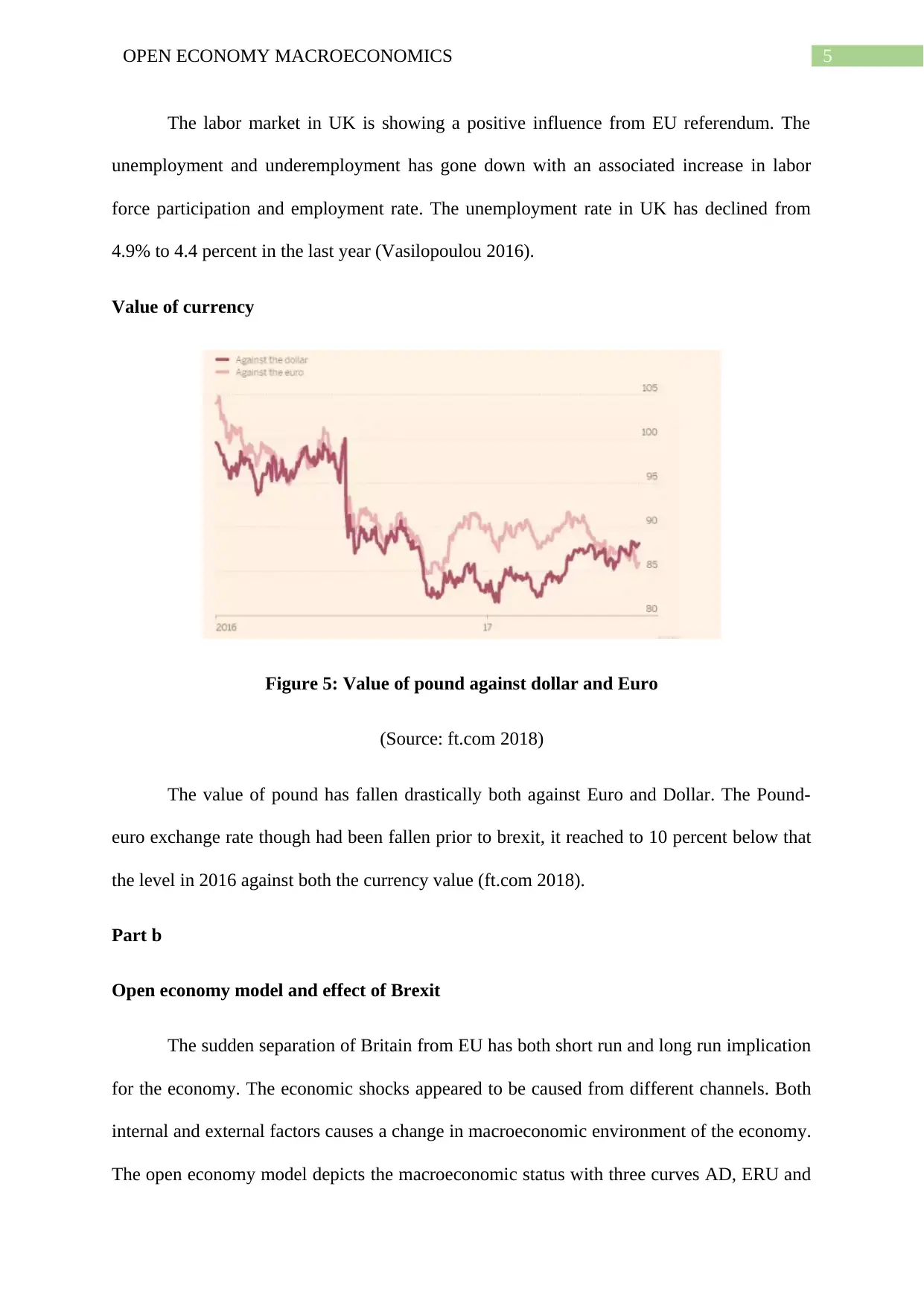
5OPEN ECONOMY MACROECONOMICS
The labor market in UK is showing a positive influence from EU referendum. The
unemployment and underemployment has gone down with an associated increase in labor
force participation and employment rate. The unemployment rate in UK has declined from
4.9% to 4.4 percent in the last year (Vasilopoulou 2016).
Value of currency
Figure 5: Value of pound against dollar and Euro
(Source: ft.com 2018)
The value of pound has fallen drastically both against Euro and Dollar. The Pound-
euro exchange rate though had been fallen prior to brexit, it reached to 10 percent below that
the level in 2016 against both the currency value (ft.com 2018).
Part b
Open economy model and effect of Brexit
The sudden separation of Britain from EU has both short run and long run implication
for the economy. The economic shocks appeared to be caused from different channels. Both
internal and external factors causes a change in macroeconomic environment of the economy.
The open economy model depicts the macroeconomic status with three curves AD, ERU and
The labor market in UK is showing a positive influence from EU referendum. The
unemployment and underemployment has gone down with an associated increase in labor
force participation and employment rate. The unemployment rate in UK has declined from
4.9% to 4.4 percent in the last year (Vasilopoulou 2016).
Value of currency
Figure 5: Value of pound against dollar and Euro
(Source: ft.com 2018)
The value of pound has fallen drastically both against Euro and Dollar. The Pound-
euro exchange rate though had been fallen prior to brexit, it reached to 10 percent below that
the level in 2016 against both the currency value (ft.com 2018).
Part b
Open economy model and effect of Brexit
The sudden separation of Britain from EU has both short run and long run implication
for the economy. The economic shocks appeared to be caused from different channels. Both
internal and external factors causes a change in macroeconomic environment of the economy.
The open economy model depicts the macroeconomic status with three curves AD, ERU and
⊘ This is a preview!⊘
Do you want full access?
Subscribe today to unlock all pages.

Trusted by 1+ million students worldwide
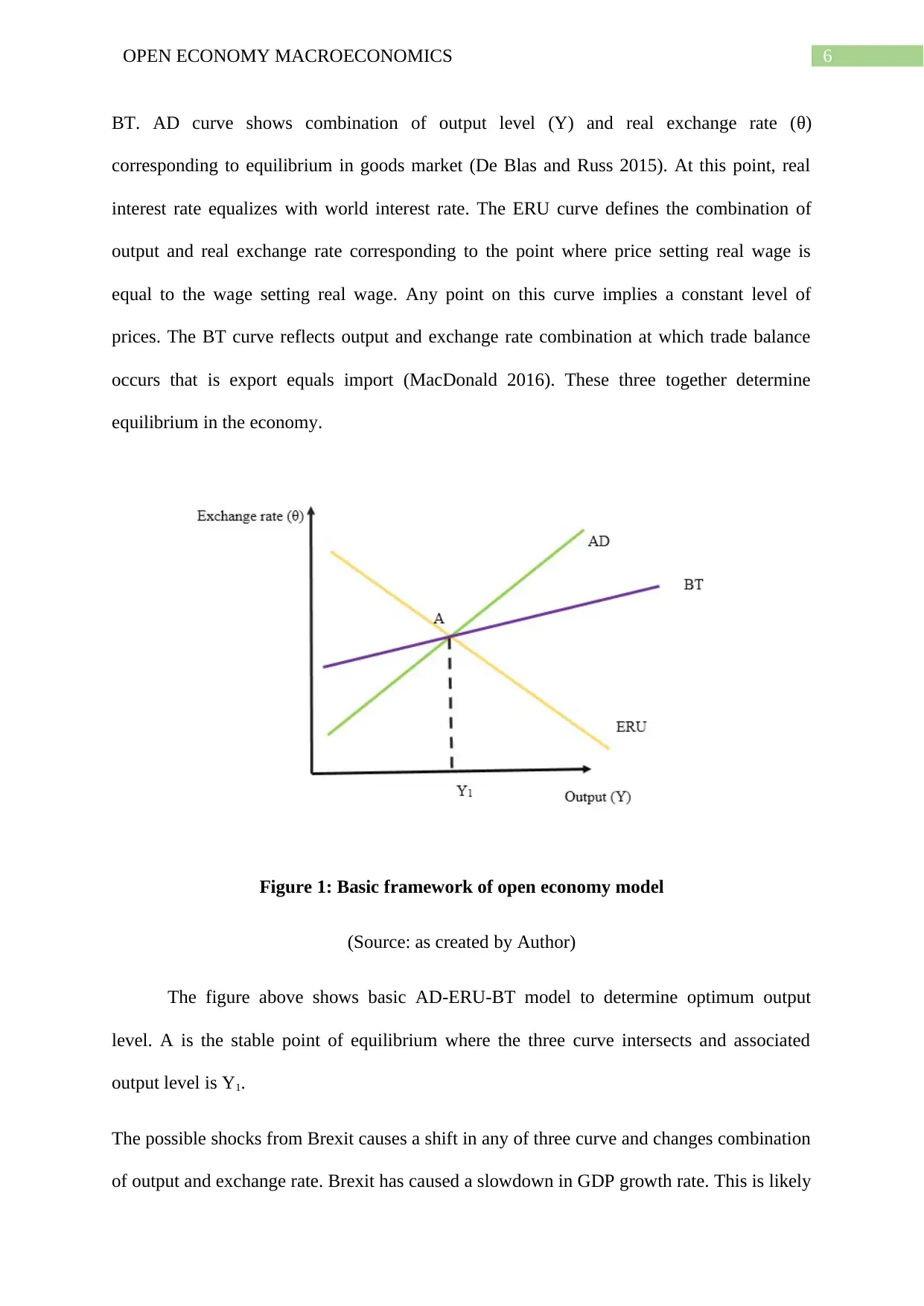
6OPEN ECONOMY MACROECONOMICS
BT. AD curve shows combination of output level (Y) and real exchange rate (θ)
corresponding to equilibrium in goods market (De Blas and Russ 2015). At this point, real
interest rate equalizes with world interest rate. The ERU curve defines the combination of
output and real exchange rate corresponding to the point where price setting real wage is
equal to the wage setting real wage. Any point on this curve implies a constant level of
prices. The BT curve reflects output and exchange rate combination at which trade balance
occurs that is export equals import (MacDonald 2016). These three together determine
equilibrium in the economy.
Figure 1: Basic framework of open economy model
(Source: as created by Author)
The figure above shows basic AD-ERU-BT model to determine optimum output
level. A is the stable point of equilibrium where the three curve intersects and associated
output level is Y1.
The possible shocks from Brexit causes a shift in any of three curve and changes combination
of output and exchange rate. Brexit has caused a slowdown in GDP growth rate. This is likely
BT. AD curve shows combination of output level (Y) and real exchange rate (θ)
corresponding to equilibrium in goods market (De Blas and Russ 2015). At this point, real
interest rate equalizes with world interest rate. The ERU curve defines the combination of
output and real exchange rate corresponding to the point where price setting real wage is
equal to the wage setting real wage. Any point on this curve implies a constant level of
prices. The BT curve reflects output and exchange rate combination at which trade balance
occurs that is export equals import (MacDonald 2016). These three together determine
equilibrium in the economy.
Figure 1: Basic framework of open economy model
(Source: as created by Author)
The figure above shows basic AD-ERU-BT model to determine optimum output
level. A is the stable point of equilibrium where the three curve intersects and associated
output level is Y1.
The possible shocks from Brexit causes a shift in any of three curve and changes combination
of output and exchange rate. Brexit has caused a slowdown in GDP growth rate. This is likely
Paraphrase This Document
Need a fresh take? Get an instant paraphrase of this document with our AI Paraphraser
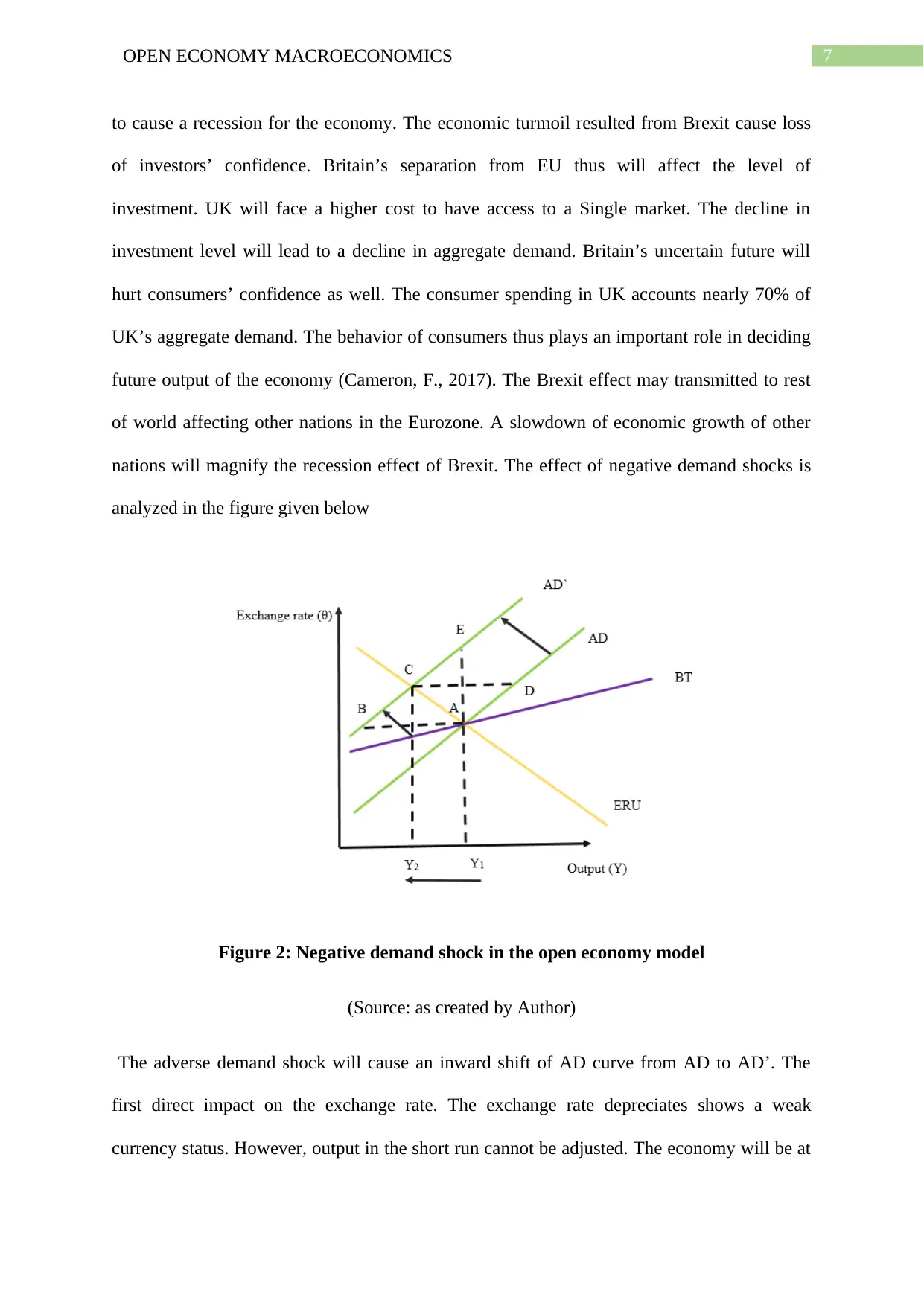
7OPEN ECONOMY MACROECONOMICS
to cause a recession for the economy. The economic turmoil resulted from Brexit cause loss
of investors’ confidence. Britain’s separation from EU thus will affect the level of
investment. UK will face a higher cost to have access to a Single market. The decline in
investment level will lead to a decline in aggregate demand. Britain’s uncertain future will
hurt consumers’ confidence as well. The consumer spending in UK accounts nearly 70% of
UK’s aggregate demand. The behavior of consumers thus plays an important role in deciding
future output of the economy (Cameron, F., 2017). The Brexit effect may transmitted to rest
of world affecting other nations in the Eurozone. A slowdown of economic growth of other
nations will magnify the recession effect of Brexit. The effect of negative demand shocks is
analyzed in the figure given below
Figure 2: Negative demand shock in the open economy model
(Source: as created by Author)
The adverse demand shock will cause an inward shift of AD curve from AD to AD’. The
first direct impact on the exchange rate. The exchange rate depreciates shows a weak
currency status. However, output in the short run cannot be adjusted. The economy will be at
to cause a recession for the economy. The economic turmoil resulted from Brexit cause loss
of investors’ confidence. Britain’s separation from EU thus will affect the level of
investment. UK will face a higher cost to have access to a Single market. The decline in
investment level will lead to a decline in aggregate demand. Britain’s uncertain future will
hurt consumers’ confidence as well. The consumer spending in UK accounts nearly 70% of
UK’s aggregate demand. The behavior of consumers thus plays an important role in deciding
future output of the economy (Cameron, F., 2017). The Brexit effect may transmitted to rest
of world affecting other nations in the Eurozone. A slowdown of economic growth of other
nations will magnify the recession effect of Brexit. The effect of negative demand shocks is
analyzed in the figure given below
Figure 2: Negative demand shock in the open economy model
(Source: as created by Author)
The adverse demand shock will cause an inward shift of AD curve from AD to AD’. The
first direct impact on the exchange rate. The exchange rate depreciates shows a weak
currency status. However, output in the short run cannot be adjusted. The economy will be at
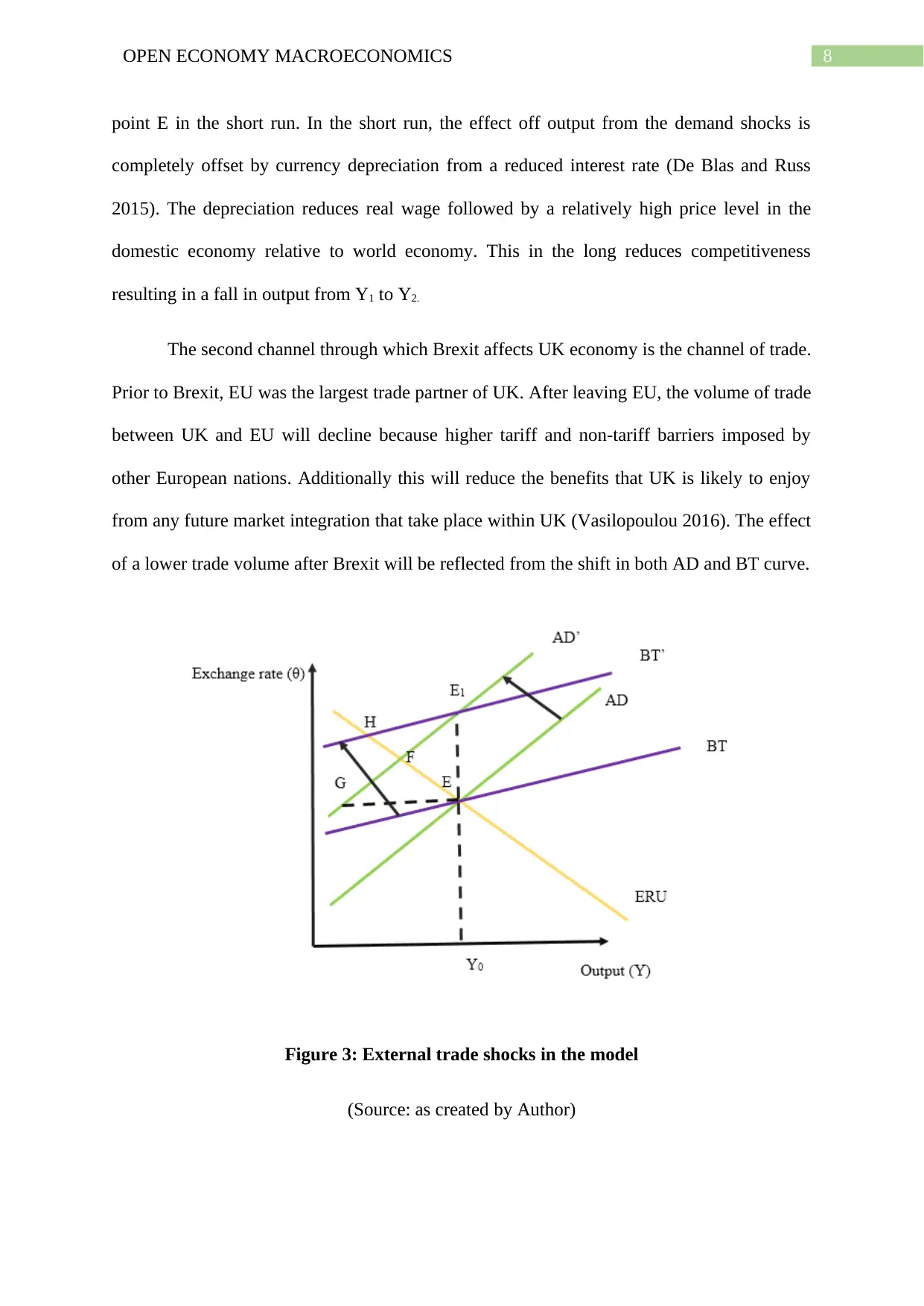
8OPEN ECONOMY MACROECONOMICS
point E in the short run. In the short run, the effect off output from the demand shocks is
completely offset by currency depreciation from a reduced interest rate (De Blas and Russ
2015). The depreciation reduces real wage followed by a relatively high price level in the
domestic economy relative to world economy. This in the long reduces competitiveness
resulting in a fall in output from Y1 to Y2.
The second channel through which Brexit affects UK economy is the channel of trade.
Prior to Brexit, EU was the largest trade partner of UK. After leaving EU, the volume of trade
between UK and EU will decline because higher tariff and non-tariff barriers imposed by
other European nations. Additionally this will reduce the benefits that UK is likely to enjoy
from any future market integration that take place within UK (Vasilopoulou 2016). The effect
of a lower trade volume after Brexit will be reflected from the shift in both AD and BT curve.
Figure 3: External trade shocks in the model
(Source: as created by Author)
point E in the short run. In the short run, the effect off output from the demand shocks is
completely offset by currency depreciation from a reduced interest rate (De Blas and Russ
2015). The depreciation reduces real wage followed by a relatively high price level in the
domestic economy relative to world economy. This in the long reduces competitiveness
resulting in a fall in output from Y1 to Y2.
The second channel through which Brexit affects UK economy is the channel of trade.
Prior to Brexit, EU was the largest trade partner of UK. After leaving EU, the volume of trade
between UK and EU will decline because higher tariff and non-tariff barriers imposed by
other European nations. Additionally this will reduce the benefits that UK is likely to enjoy
from any future market integration that take place within UK (Vasilopoulou 2016). The effect
of a lower trade volume after Brexit will be reflected from the shift in both AD and BT curve.
Figure 3: External trade shocks in the model
(Source: as created by Author)
⊘ This is a preview!⊘
Do you want full access?
Subscribe today to unlock all pages.

Trusted by 1+ million students worldwide
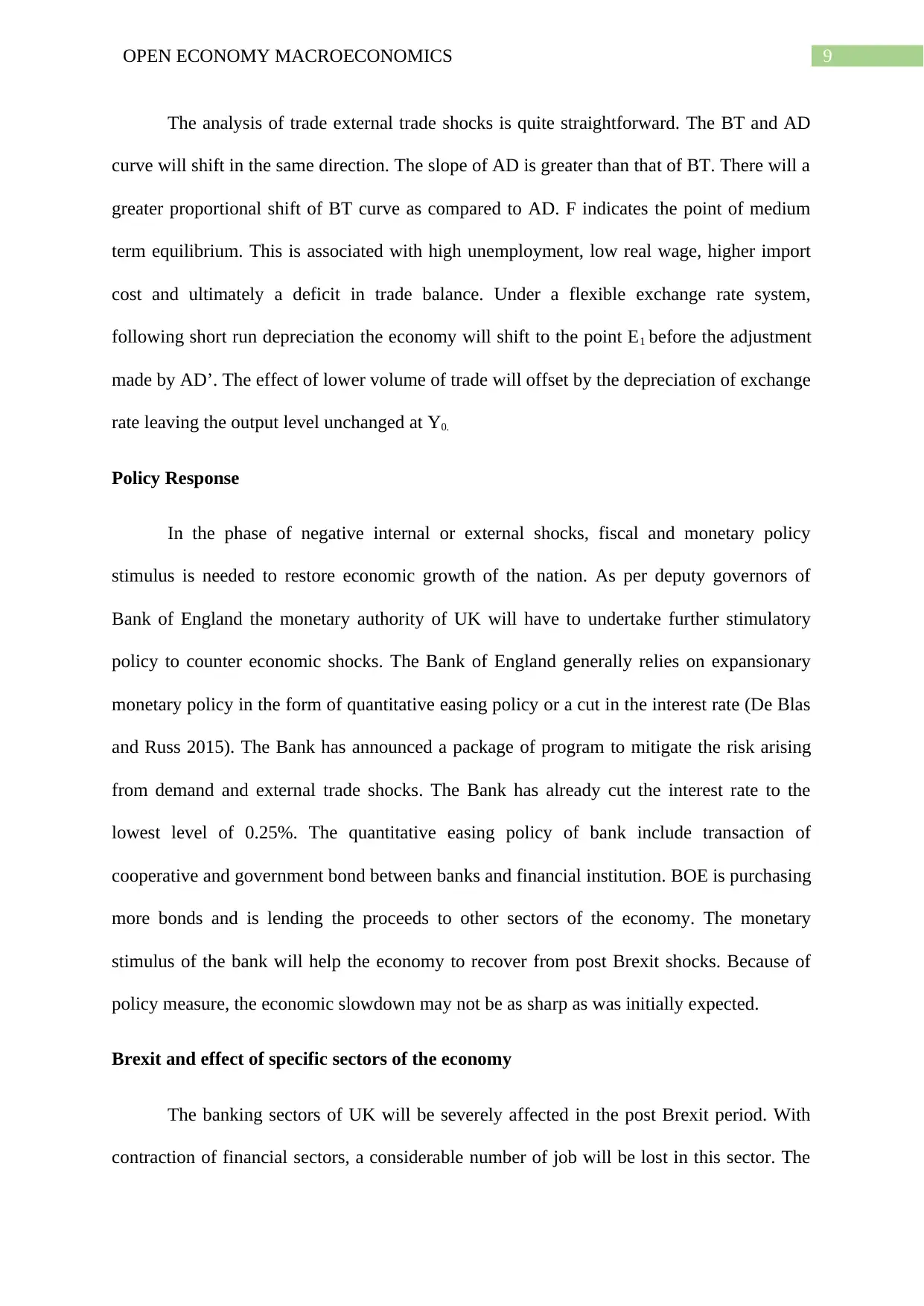
9OPEN ECONOMY MACROECONOMICS
The analysis of trade external trade shocks is quite straightforward. The BT and AD
curve will shift in the same direction. The slope of AD is greater than that of BT. There will a
greater proportional shift of BT curve as compared to AD. F indicates the point of medium
term equilibrium. This is associated with high unemployment, low real wage, higher import
cost and ultimately a deficit in trade balance. Under a flexible exchange rate system,
following short run depreciation the economy will shift to the point E1 before the adjustment
made by AD’. The effect of lower volume of trade will offset by the depreciation of exchange
rate leaving the output level unchanged at Y0.
Policy Response
In the phase of negative internal or external shocks, fiscal and monetary policy
stimulus is needed to restore economic growth of the nation. As per deputy governors of
Bank of England the monetary authority of UK will have to undertake further stimulatory
policy to counter economic shocks. The Bank of England generally relies on expansionary
monetary policy in the form of quantitative easing policy or a cut in the interest rate (De Blas
and Russ 2015). The Bank has announced a package of program to mitigate the risk arising
from demand and external trade shocks. The Bank has already cut the interest rate to the
lowest level of 0.25%. The quantitative easing policy of bank include transaction of
cooperative and government bond between banks and financial institution. BOE is purchasing
more bonds and is lending the proceeds to other sectors of the economy. The monetary
stimulus of the bank will help the economy to recover from post Brexit shocks. Because of
policy measure, the economic slowdown may not be as sharp as was initially expected.
Brexit and effect of specific sectors of the economy
The banking sectors of UK will be severely affected in the post Brexit period. With
contraction of financial sectors, a considerable number of job will be lost in this sector. The
The analysis of trade external trade shocks is quite straightforward. The BT and AD
curve will shift in the same direction. The slope of AD is greater than that of BT. There will a
greater proportional shift of BT curve as compared to AD. F indicates the point of medium
term equilibrium. This is associated with high unemployment, low real wage, higher import
cost and ultimately a deficit in trade balance. Under a flexible exchange rate system,
following short run depreciation the economy will shift to the point E1 before the adjustment
made by AD’. The effect of lower volume of trade will offset by the depreciation of exchange
rate leaving the output level unchanged at Y0.
Policy Response
In the phase of negative internal or external shocks, fiscal and monetary policy
stimulus is needed to restore economic growth of the nation. As per deputy governors of
Bank of England the monetary authority of UK will have to undertake further stimulatory
policy to counter economic shocks. The Bank of England generally relies on expansionary
monetary policy in the form of quantitative easing policy or a cut in the interest rate (De Blas
and Russ 2015). The Bank has announced a package of program to mitigate the risk arising
from demand and external trade shocks. The Bank has already cut the interest rate to the
lowest level of 0.25%. The quantitative easing policy of bank include transaction of
cooperative and government bond between banks and financial institution. BOE is purchasing
more bonds and is lending the proceeds to other sectors of the economy. The monetary
stimulus of the bank will help the economy to recover from post Brexit shocks. Because of
policy measure, the economic slowdown may not be as sharp as was initially expected.
Brexit and effect of specific sectors of the economy
The banking sectors of UK will be severely affected in the post Brexit period. With
contraction of financial sectors, a considerable number of job will be lost in this sector. The
Paraphrase This Document
Need a fresh take? Get an instant paraphrase of this document with our AI Paraphraser
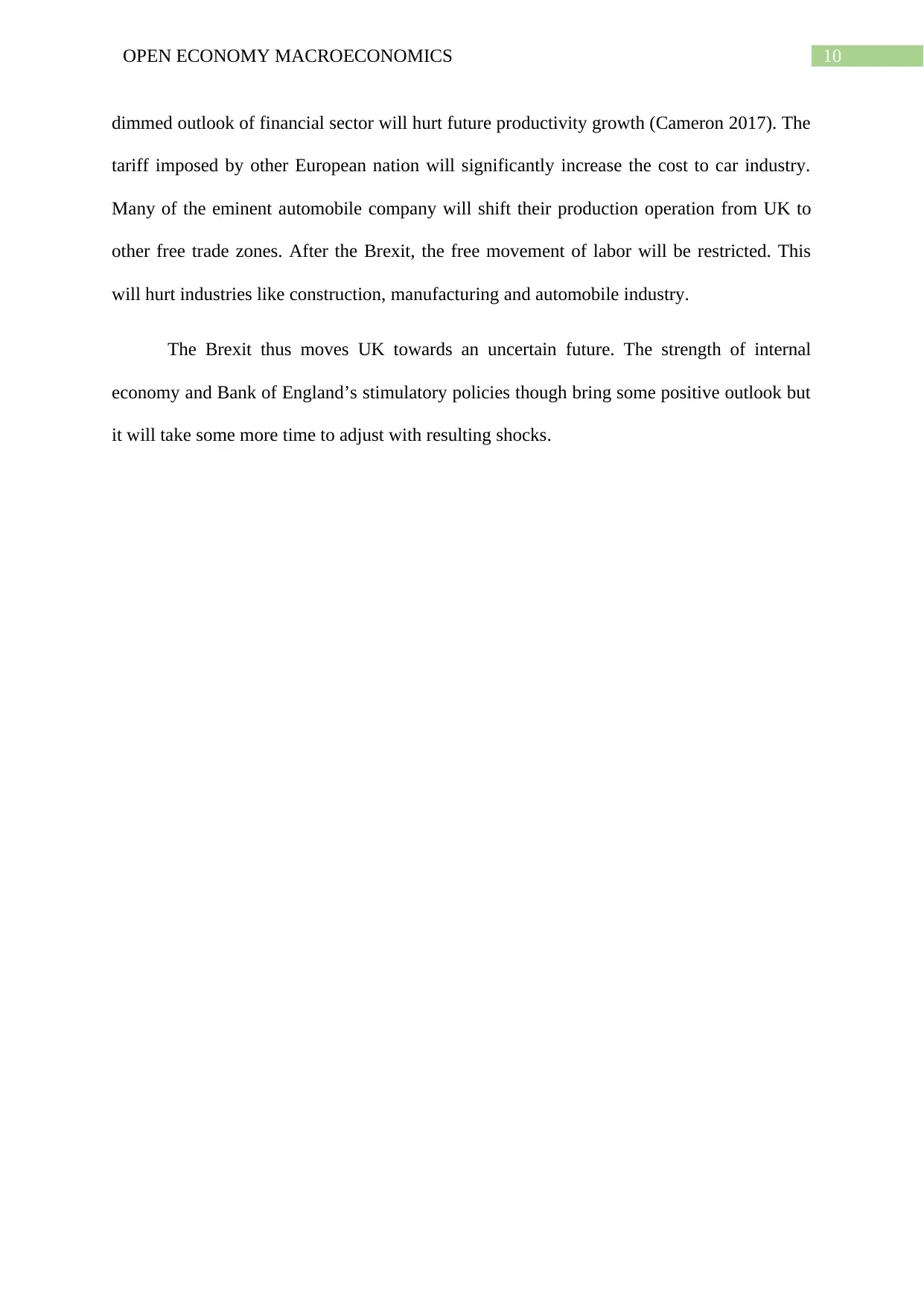
10OPEN ECONOMY MACROECONOMICS
dimmed outlook of financial sector will hurt future productivity growth (Cameron 2017). The
tariff imposed by other European nation will significantly increase the cost to car industry.
Many of the eminent automobile company will shift their production operation from UK to
other free trade zones. After the Brexit, the free movement of labor will be restricted. This
will hurt industries like construction, manufacturing and automobile industry.
The Brexit thus moves UK towards an uncertain future. The strength of internal
economy and Bank of England’s stimulatory policies though bring some positive outlook but
it will take some more time to adjust with resulting shocks.
dimmed outlook of financial sector will hurt future productivity growth (Cameron 2017). The
tariff imposed by other European nation will significantly increase the cost to car industry.
Many of the eminent automobile company will shift their production operation from UK to
other free trade zones. After the Brexit, the free movement of labor will be restricted. This
will hurt industries like construction, manufacturing and automobile industry.
The Brexit thus moves UK towards an uncertain future. The strength of internal
economy and Bank of England’s stimulatory policies though bring some positive outlook but
it will take some more time to adjust with resulting shocks.
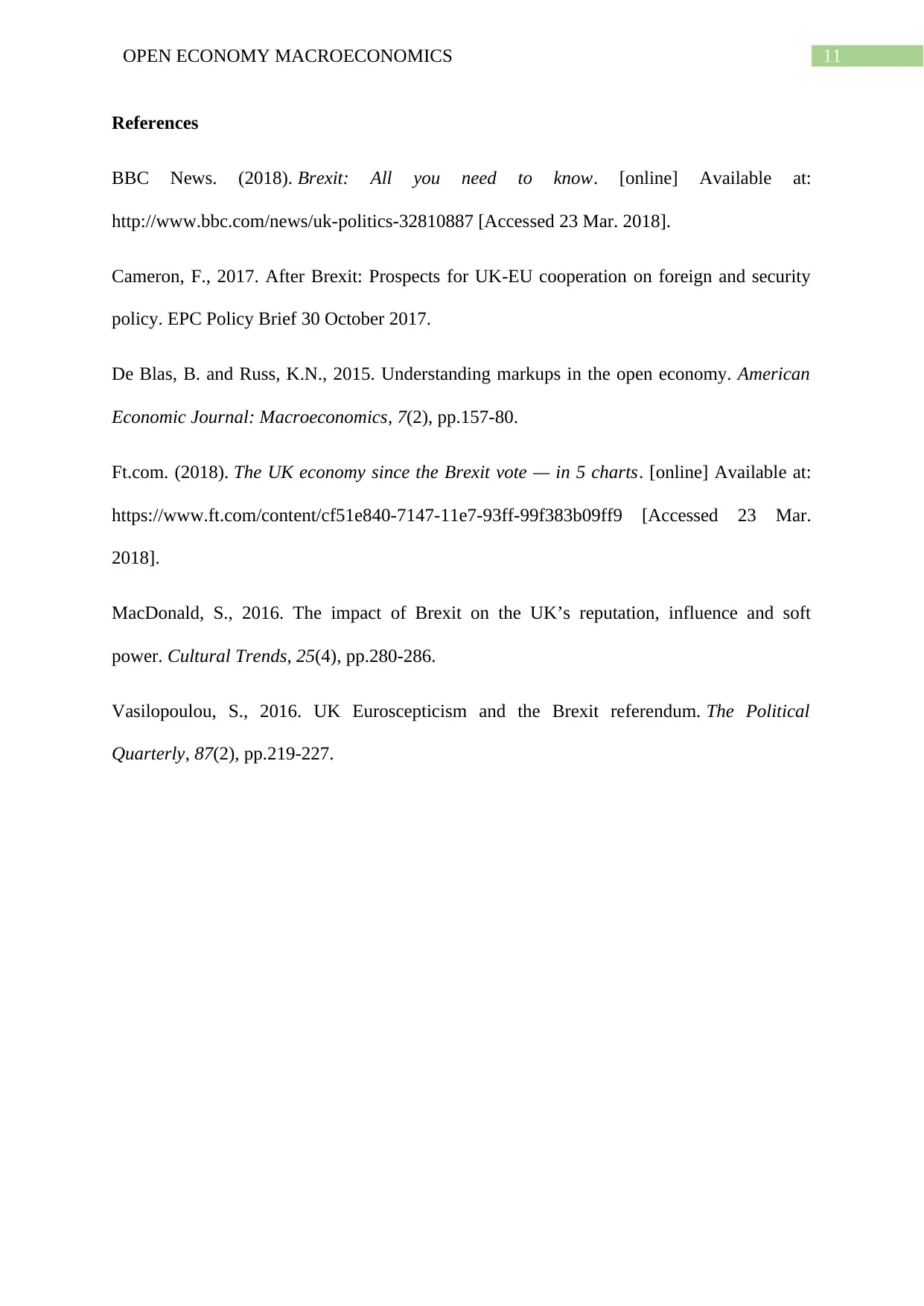
11OPEN ECONOMY MACROECONOMICS
References
BBC News. (2018). Brexit: All you need to know. [online] Available at:
http://www.bbc.com/news/uk-politics-32810887 [Accessed 23 Mar. 2018].
Cameron, F., 2017. After Brexit: Prospects for UK-EU cooperation on foreign and security
policy. EPC Policy Brief 30 October 2017.
De Blas, B. and Russ, K.N., 2015. Understanding markups in the open economy. American
Economic Journal: Macroeconomics, 7(2), pp.157-80.
Ft.com. (2018). The UK economy since the Brexit vote — in 5 charts. [online] Available at:
https://www.ft.com/content/cf51e840-7147-11e7-93ff-99f383b09ff9 [Accessed 23 Mar.
2018].
MacDonald, S., 2016. The impact of Brexit on the UK’s reputation, influence and soft
power. Cultural Trends, 25(4), pp.280-286.
Vasilopoulou, S., 2016. UK Euroscepticism and the Brexit referendum. The Political
Quarterly, 87(2), pp.219-227.
References
BBC News. (2018). Brexit: All you need to know. [online] Available at:
http://www.bbc.com/news/uk-politics-32810887 [Accessed 23 Mar. 2018].
Cameron, F., 2017. After Brexit: Prospects for UK-EU cooperation on foreign and security
policy. EPC Policy Brief 30 October 2017.
De Blas, B. and Russ, K.N., 2015. Understanding markups in the open economy. American
Economic Journal: Macroeconomics, 7(2), pp.157-80.
Ft.com. (2018). The UK economy since the Brexit vote — in 5 charts. [online] Available at:
https://www.ft.com/content/cf51e840-7147-11e7-93ff-99f383b09ff9 [Accessed 23 Mar.
2018].
MacDonald, S., 2016. The impact of Brexit on the UK’s reputation, influence and soft
power. Cultural Trends, 25(4), pp.280-286.
Vasilopoulou, S., 2016. UK Euroscepticism and the Brexit referendum. The Political
Quarterly, 87(2), pp.219-227.
⊘ This is a preview!⊘
Do you want full access?
Subscribe today to unlock all pages.

Trusted by 1+ million students worldwide
1 out of 12
Related Documents
Your All-in-One AI-Powered Toolkit for Academic Success.
+13062052269
info@desklib.com
Available 24*7 on WhatsApp / Email
![[object Object]](/_next/static/media/star-bottom.7253800d.svg)
Unlock your academic potential
Copyright © 2020–2025 A2Z Services. All Rights Reserved. Developed and managed by ZUCOL.





